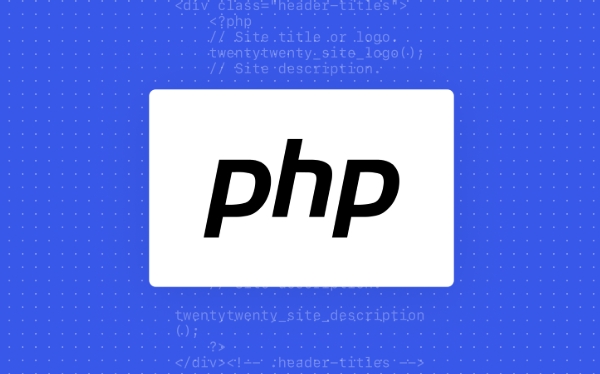Exploring the PHP File: Structure and Purpose
Jul 16, 2025 am 03:47 AMThe core function of PHP files is to handle dynamic web content, combining server-side logic and front-end display. A typical structure includes four steps: introducing configuration files, starting a session, loading an autoloader, and routing and distribution. PHP allows dynamic content to be embedded in HTML, suitable for building template pages, but it is recommended to use the template engine to separate logic from views. In the file introduction method, require is used to ensure that the script terminates in errors, and include is used for optional modules; it is recommended to use the _once version uniformly to prevent duplicate loading. The code organization recommends a separate file for each class, and classifies functions into tool classes or services, and uses namespaces to improve readability and automatic loading efficiency.

The core function of PHP files is to handle dynamic web content and combine server-side logic with front-end display. A typical PHP file not only contains HTML code, but also embeds dynamic functions such as variables, conditional judgment, loop structure, and database interaction. Its structure looks simple, but it carries complete web application logic behind it.

Basic file structure: start from the entrance
Most PHP projects have a main entry file, such as index.php , which is responsible for loading the configuration, initializing the framework, and starting the request processing process.
Typical structures may include:

- Introduce configuration files (such as
config.php) - Start the session (session_start())
- Loading the autoloader (Composer's autoload.php)
- Routing distribution or controller call
For example:
<?php require_once 'config.php'; session_start(); require_once 'vendor/autoload.php'; $router = new Router(); $router->dispatch();
Although this structure is short, it clearly divides the different stages of program startup, making it easy to maintain and expand.

Why do you need to mix HTML and PHP?
One of the original design goals of PHP was to enable developers to easily embed dynamic content in HTML. Therefore, you often see writing styles like this:
<h1>Welcome, <?php echo $username; ?></h1>
This approach is great for building template pages. Of course, it is recommended to use template engines (such as Twig or Blade) in actual development to separate logic and views to improve readability and maintainability.
It should be noted that when writing mixed writing, you should avoid writing too much business logic in HTML, otherwise it will cause bloat and difficult to maintain.
The difference between inclusion and introduction: include or require?
PHP provides four ways to import external files: include , include_once , require and require_once .
Their differences are mainly in error handling:
-
include: If the file does not exist, only a warning will be generated and the script will continue to be executed -
require: If the file does not exist, a fatal error will be generated and the script will stop executing
So usually:
- Configuration files and core library use
require_once - Optional modules or templates can be
include
It is recommended to use the _once version uniformly to prevent duplicate loading from causing problems.
How functions and classes are organized
A PHP file can define only one class, or it can contain multiple functions or be used in a mixed manner. However, for better readability and compliance with PSR specifications, it is recommended:
- A separate file for each class
- Try to classify functions into tool classes or encapsulate them into services
- Organize code levels using namespace
For example:
// File path: App/Controllers/UserController.php
namespace App\Controllers;
class UserController {
public function showProfile($id) {
// ...
}
}This clear structure is also conducive to the automatic loading mechanism to identify the classpath.
Basically that's it. Understanding the structure and purpose of PHP files will help write more standardized and easy-to-maintain code.
The above is the detailed content of Exploring the PHP File: Structure and Purpose. For more information, please follow other related articles on the PHP Chinese website!

Hot AI Tools

Undress AI Tool
Undress images for free

Undresser.AI Undress
AI-powered app for creating realistic nude photos

AI Clothes Remover
Online AI tool for removing clothes from photos.

Clothoff.io
AI clothes remover

Video Face Swap
Swap faces in any video effortlessly with our completely free AI face swap tool!

Hot Article

Hot Tools

Notepad++7.3.1
Easy-to-use and free code editor

SublimeText3 Chinese version
Chinese version, very easy to use

Zend Studio 13.0.1
Powerful PHP integrated development environment

Dreamweaver CS6
Visual web development tools

SublimeText3 Mac version
God-level code editing software (SublimeText3)

Hot Topics
 How to open php files on mobile phone
Nov 13, 2023 am 11:08 AM
How to open php files on mobile phone
Nov 13, 2023 am 11:08 AM
To open a php file on a mobile phone, you need to set up a server environment that can run php on the mobile phone and upload the php file to the server. Then, enter the IP address or domain name of the server, plus the path to the php file, into the browser on your phone to open the php file and view its contents.
 How to deal with case errors in PHP file paths and generate corresponding error messages
Aug 08, 2023 pm 09:45 PM
How to deal with case errors in PHP file paths and generate corresponding error messages
Aug 08, 2023 pm 09:45 PM
How to deal with case errors in PHP file paths and generate corresponding error messages. In the process of developing PHP programs, we often encounter the problem of case errors in file paths. Since Windows and Linux systems handle file path case differently, when the program passes the test using the Windows system in the development environment, it may cause path errors when it is deployed to the Linux server. In order to solve this problem, we can use some methods to deal with the large file path
 How to open php file
Sep 01, 2023 am 11:53 AM
How to open php file
Sep 01, 2023 am 11:53 AM
Steps to open a php file: 1. Select a text editor; 2. Create a new file in the selected text editor and save it as a .php file; 3. Write PHP code in the created PHP file; 4. To run PHP files on your local computer, you need to set up a server environment; 5. After installing the server environment, you need to put the PHP files into the server directory; 6. Once you put the PHP files into the server directory, you can browse server to run it.
 how to open php file
Jan 24, 2024 pm 04:12 PM
how to open php file
Jan 24, 2024 pm 04:12 PM
Tools for opening php files: 1. Notepad++; 2. Sublime Text; 3. Visual Studio Code; 4. Eclipse; 5. XAMPP. Detailed introduction: 1. Notepad++, which is a free text editor that supports multiple programming languages, including PHP. It has functions such as syntax highlighting and code folding, making it easier to read and edit PHP code; 2. Sublime Text , a powerful text editor and more.
 Several aspects of content can be included in the .php file
Mar 06, 2023 pm 05:32 PM
Several aspects of content can be included in the .php file
Mar 06, 2023 pm 05:32 PM
What can be included in the php file: 1. The starting tag "<?php" and the ending tag "?>", all PHP code must be written inside this pair of tags; 2. The semicolon ";" is a PHP statement The delimiter also represents the instruction for code execution; 3. Comments, including single-line comments "//", multi-line comments "/* */", and Shell comments "#"; 4. Line breaks, which can Enhance the readability of the code; 5. Code segments (such as functions, etc.).
 What code can a PHP file contain?
Aug 01, 2023 pm 01:34 PM
What code can a PHP file contain?
Aug 01, 2023 pm 01:34 PM
PHP files can contain code: 1. PHP code, used to complete various server-side tasks; 2. HTML code, used to define the structure and layout of the web page; 3. CSS code, used to define the style of the web page; 4. JavaScript Code, used to implement various dynamic interaction functions in web pages; 5. SQL code, used to operate the database; 6. The file contains code, which can modularize the code; 7. Third-party libraries and frameworks, which can be quickly constructed Feature-rich application.
 What are the prerequisites for running PHP programs?
Mar 26, 2024 pm 03:45 PM
What are the prerequisites for running PHP programs?
Mar 26, 2024 pm 03:45 PM
Title: Prerequisites and examples for running PHP programs. PHP is a scripting language widely used in web development. Many websites use PHP to run their dynamic content. To successfully run a PHP program, some prerequisites must be met. The following will introduce the prerequisites for running PHP programs and provide specific code examples. Server environment First of all, PHP programs need to run normally in a server environment that supports the PHP language. The most common server environment is an Apache server and requires a PHP interpreter to be installed
 How to handle PHP file encoding errors and generate corresponding error messages
Aug 06, 2023 pm 02:09 PM
How to handle PHP file encoding errors and generate corresponding error messages
Aug 06, 2023 pm 02:09 PM
How to handle PHP file encoding errors and generate corresponding error messages. When developing PHP applications, file encoding errors are often encountered. These errors may cause the program to fail to run properly or display garbled code in front of the user. In order to better handle these errors and generate corresponding error messages, we can take some common solutions. Determine the file encoding First, we need to determine the encoding format of the file. Common encoding formats include UTF-8, GBK, etc. You can view it through the "Save As" function of your text editor.






